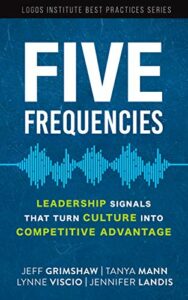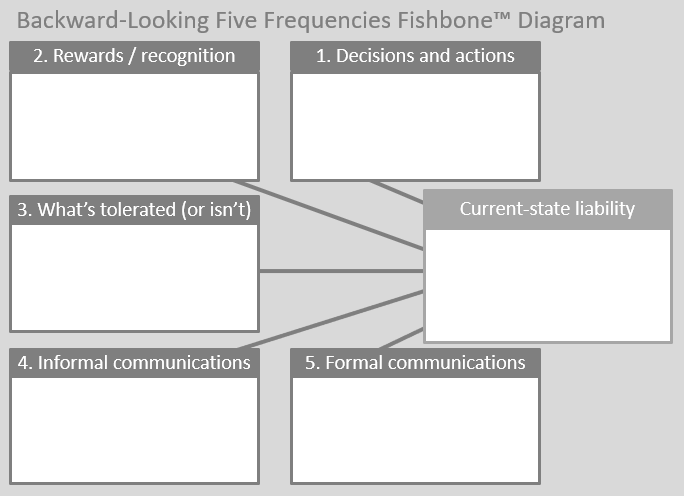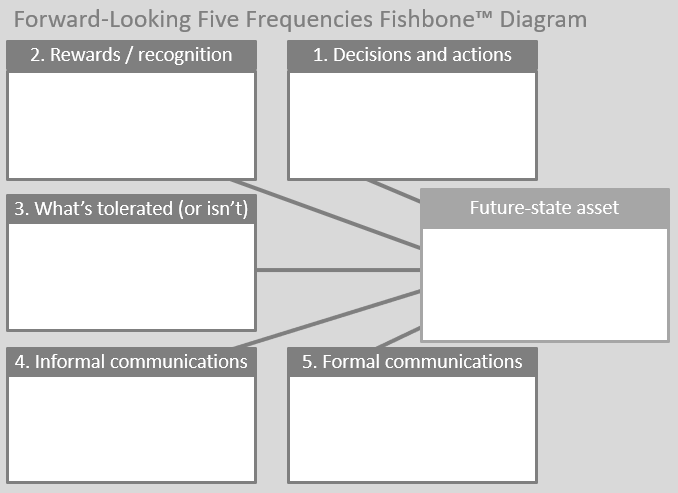Make Your Culture an Asset
“Your organization’s culture: It’s either an asset or a liability. At this very moment, it’s either lifting your business performance or “eating your strategy for breakfast.” How do you ensure it’s the former, not the latter?”
Those words are printed on the back cover of Five Frequencies: Leadership Signals that Turn Culture into Competitive Advantage . As someone who studies and practices culture change, I took notice.
Jeff Grimshaw, Tanya Mann, Lynne Viscio, and Jennifer Landis collaborated to share their views on how leaders drive culture change. They argue that to make a good culture great, leaders must deliberately transmit strong and steady signals. Five Frequencies prescribes more than 20 practical Signal Boosts for turning culture into competitive advantage. I followed up with the authors to learn more about their leadership philosophy.
Learn from the Mistakes of A Rotten Culture
Would you share an example of where “culture” was rotten and the ensuing results?
Wells Fargo springs to mind. Dust off that copy of Good to Great on your bookshelf and remember that not long ago Jim Collin’s very credibly lionized them. But the most recent Barron’s survey finds that they are now the least-respected company in America, right behind Big Tobacco’s Philip Morris. What happened in between? A Vanity Fair feature article chalked it up to a “cutthroat culture that (allegedly) drove bankers to fraud.” Warren Buffet, a ticked-off shareholder, came to recognize that the Wells Fargo culture “incentivized the wrong behavior.” He was right. But that’s not the only thing rotten about that culture. What you reward is one thing that shapes culture; what you tolerate is another. On that score, the company’s Code of Ethics claimed that “gaming” (the manipulation and / or misrepresentation of sales or referrals) was against the rules and grounds for dismissal. But for more than ten years, anyone who called attention to the blatant gaming was either ignored or actively silenced. According to one former employee, “Management made it clear that no employee was allowed to complain about the unethical practices that were going on within the branch.”
CEO John Stumpf set the tone. Everyone came to know that Stumpf did not want to hear bad news or deal with conflict. He attributed that to a preference for “Minnesota Nice.” But that, in turn, further motivated those around Stumpf to sweep problems under the rug.
One of the things we preach in the book is for leaders to be more “long-term greedy.” There’s nothing wrong with operating out of self-interest. Let’s be candid: That’s part of the job. But you should pick a longer time horizon for calculating ROI on your leadership choices. So many of the things leaders do that create lousy cultures are decisions that produce quick payoffs. That’s what Wells Fargo did. All that corruption helped them hit quarterly EPS targets. But it’s not sustainable. Ultimately, lousy cultures put reputations and actual business performance at great risk.
5 Leadership Frequencies
That example highlights the glaring importance of focusing on culture. You say that leaders are broadcasting on Five Frequencies. Would you share them and how you arrived at these five?
We’re in the business of helping clients measure and manage culture. We help them measurably define the culture that would give them a source of competitive advantage, assess the gap between their current- and desired-state culture, and then close the gap between “the culture they HAVE” and “the culture they NEED.”
Over 20 years, we looked at the difference between leadership teams that successfully “moved the needle” on the culture and those that didn’t. It became clear pretty quickly: The leaders who turn culture into competitive advantage do that by transmitting strong and steady signals on Five Frequencies:
- Their decisions and actions
- What they reward and recognize
- What they tolerate (or don’t)
- How they show up informally
- Their formal communications
To be clear, all leaders are constantly transmitting culture-shaping signals across these Five Frequencies, intentionally or not. Turning culture into competitive advantage requires that leaders are intentional. They are consistent and deliberate about their signals.
What Leaders Tolerate
Fantastic points and reading the book gave so many examples to make them come to life. Let’s just touch on a few. What leaders tolerate (or don’t). Tell us a little more about this one.
When it comes to culture, no matter what else you do right… you and your leadership may ultimately be defined by what you tolerate. For example, we talk in the book about Pope Francis. Since he became pontiff, he has actively worked to reshape the culture of the Vatican and, more broadly, the Catholic Church. The signals he transmits across the Five Frequencies are a departure from his predecessor’s. There’s a lot to admire, in our opinion, like the way he shook up the Vatican Bank. But the thing that hangs over his leadership—and the Church—is what they tolerated in the way of child abuse. There’s a debate over what Pope Francis knew, when he knew about it, and what he did (or didn’t) do about it.
On a smaller scale, the same principle applies to leaders at every level in every organization. You’re defined by what you tolerate. And our research says that this is the Frequency that more leaders struggle with than any other. A lot of it boils down to excuse making and rationalization.
For example, leaders think, “I can’t hold this person accountable because…it will make me feel bad or awkward when I deliver tough feedback (or fire them).” Or “I can’t hold this person accountable because…they get great results (even while they break the rules and alienate the people around them).” That one will eventually come back to bite you. Same with: “I can’t hold this person accountable because…the thing they did wrong is just a small thing.” That’s a dangerous, slippery slope. Or “I don’t need to hold this person accountable because…my high performers will pick up the slack.” This one is actually a huge problem in a lot of organizations, where too many leaders just keep giving high performers more work to do to compensate for their unwillingness to hold low performers accountable. “The award for winning the pie-eating contest is…more pie!” Again, very costly in the long run. It’s just not sustainable.
How about the fourth one “How they show up informally.” What are some strategies and tips to show up as a leader in this way?
How you show up in informal settings, when you’re not working from a script or a PowerPoint deck, has a huge impact on culture. And it starts with simply showing up…going where your people are. For example, let’s talk about Tim Rausch, Chief Nuclear Officer for the Tennessee Valley Authority. He blocks off time for “getting out there” three days a week. He often grabs a next-level leader and they walk together. Tim will say to them: “Tell me what you see. Tell me what you hear.” He’ll watch how that leader interacts with people out in the field. And if he thinks they can be more observant, or more engaging, he’ll (discreetly) coach them on the spot.
When he was a plant manager and then a Site VP, he came in on Thanksgiving and Christmas to ask his people how they were doing. They’d typically ask: “Why are you here?” And Tim would say, “Because you are.”
On one occasion, the company sent a civil engineer to the top of a 500-foot cooling tower to do a walkdown. Tim asked the engineer: “What are you looking for while you’re up there?” The engineer mentioned concrete that’s falling or cracking, the handrail weakening, things like that, and then joked: “You should come with me.”
Joke or not, Tim thought seriously about it. Tim’s boss discouraged it. But Tim said, “If it’s not safe for me up there then why are we sending an employee?” Word of Tim’s plans got out and a multitude assembled below to watch him climb the tower, after which he conducted a three-hour inspection with the civil engineer. Tim used the time to ask him if he thought there were ways the plant could better utilize his skillset. Back on the ground, Tim acted on the answers.
That’s the kind of leading you can’t do from your office.
Another great tip comes from Steve Zanella, a friend who happens to be a senior executive in the MGM organization. One of his principles is: Take the shoeshine guy to lunch. “Everyone—both customers and employees—talks to him,” Steve told us. “He can tell you what’s moving in the right direction—and where we’re getting loose and need to tighten up operations. I’d need to conduct a dozen customer and employee focus groups to fill in the gaps if I wasn’t having regular check-ins with the shoeshine guy.” Obviously, if you’re not running a hotel or an airport, you probably don’t employ a shoeshine guy. But I bet you can likely find the equivalent.
Relinquish Your Rafts
I love “relinquish your rafts.” Would you share the parable?
Sure!
A traveler on an important journey comes to a raging river. It seems there’s no way to cross. And that’s terrible news, because this is an important journey. Fortunately, she spots a rickety old raft on the bank, off in the brush. With trepidation, she pushes the raft into the water, hops on, and amazingly, uses it to reach the other side. She’s able to continue her important journey. She thinks: I may encounter other raging rivers down the path, so I must keep this raft. So she carries the raft on her back as she continues her journey. It’s a heavy raft and it slows her down. When fellow travelers point this out, she’s incredulous: “You don’t understand,” she says. “If it wasn’t for this raft, I wouldn’t be where I am today!” And she’s right. That’s literally true. The problem is: If she doesn’t put down the raft, she may not get to where she needs to go on her important journey.
This parable seems to resonate with a lot of people. Why? As many big organizations very deliberately move to more agile ways of working, leaders are finding that the controlling tendencies that helped bring them this far in their careers are less useful now. Their raft might be micromanaging what gets done and how it gets done. Putting down the raft means describing targeted outcomes then empowering people closest to the work to make the decisions about how to achieve those targets.
How do you encourage leaders to recognize that they are carrying a raft and then convince them to put it down?
Just like in the parable, it’s much easier for us to notice the rafts that OTHER people are carrying. So we gather anonymous feedback to help leaders get clarity about what rafts they might be carrying. Or, even better, we encourage them to give others’ explicit jurisdiction to share feedback, including tough feedback on the rafts they’re carrying.
Everyone is psychologically attached to their rafts. We try to help leaders make a very rational cost/benefit analysis about what clinging to the raft is costing them. That often creates the motivation to change. But sometimes it doesn’t. A raft that was essential for you to get this far, no matter how cumbersome or heavy, is tough to put down.
What other tips would you share with leaders who want to improve their frequencies?
I’ll share with your readers a fishbone diagramming tool that’s in the book. It will help you determine how to change your “broadcasts” in a more systemic way.
Your readers might already have experience with fishbone diagrams as a tool for analysis and continuous improvement. They’re sometimes called cause and effect diagrams. That’s because the head of the fish represents the “effect” or outcome you’re trying to explain. And then you use a handful of “bones” coming off the fish’s backbone to theorize the “causes” that produce the outcome.
Use a retrospective Five Frequencies Fishbone to reflect on how you got to the culture you have now. Think of something about the current-state culture that’s a liability, a source of competitive disadvantage. For illustration, here are some undesirable current-state outcomes that other leaders have placed in the fish head of their backward-looking fishbone diagram.
- Millennials don’t seem to KNOW the values or guiding principles that should guide their decisions and behaviors.
- Front-line employees don’t seem to consistently KNOW how their work supports the vision.
- Many field employees don’t FEEL supported and equipped to continuously improve their performance.
- Few employees FEEL they’re supported to take informed risks, “fail fast,” and learn from mistakes.
- Employees too often don’t ask for help when they need it. (DO)
- Mid-managers don’t root for each other’s success or play to win as a team. (DO)
Now draw the body of your fish with five bones coming off the spines.

Use this fishbone to identify where current-state culture came from.
Now work your way around the Five Frequencies. Looking back over the past few years, what were the signals that you or other leaders transmitted that intentionally—or more likely, unintentionally—produced this outcome? The more candid and self-critical you are, the more helpful the resulting analysis will be. If you need help with the Fishbone analysis, ask your colleagues, or even better, your employees. When it’s complete, the retrospective Fishbone will help you identify what you need to change to get employees to more consistently know, feel, or do what you need them to know, feel, or do.
A prospective Five Frequencies Fishbone looks ahead, helping you theorize what it will take across the Five Frequencies to produce some element of your desired-state culture. Pick something that you need employees to more consistently know, feel, or do. This becomes the head of your fish.
For illustration, here are some desired-state outcomes that other leaders have placed in the fish head of their forward-looking fishbone diagram.
- Employees in the support functions KNOW as well as customer-facing employees how their work contributes to our “North Star.”
- New employees KNOW examples of us living our values, even when it’s inconvenient.
- Operations employees FEEL increasingly able to get things done with the right resources and processes rather than depending on “personal heroics.”
- Team members FEEL local leaders are genuinely committed to our agile transformation.
- Employees DO manage conflict constructively rather than avoiding it or taking it personally.
- Individual contributors DO take charge and are proactive when they see issues.
Then work your way around the Five Frequencies: What signals will you likely need to transmit for your employees to more consistently know, feel, or do what you need them to? (Shameless plug: If you need help, the book describes more than 20 practical signal boosts.) Again, the more candid and self-critical you are, the more helpful the resulting analysis will be. Take your first cut at the analysis, and then invite colleagues and employees to weigh in.
Use this fishbone to assess what it will take to produce the culture you need for competitive advantage
And when your analysis is complete, start sending those signals! Keep ‘em strong. Keep ‘em steady. Of course, it’s not easy but it’s worth it. Because, as we’ve seen time and again, when you measurably strengthen culture, business performance follows.
For more information, see Five Frequencies: Leadership Signals that Turn Culture into Competitive Advantage .



